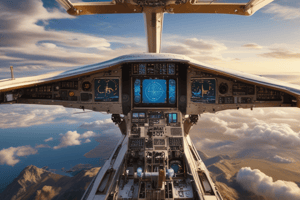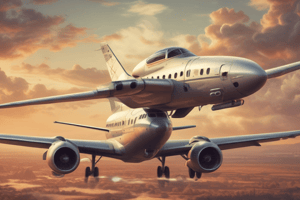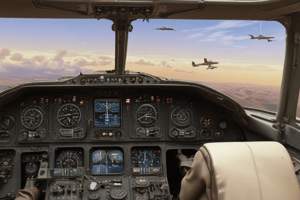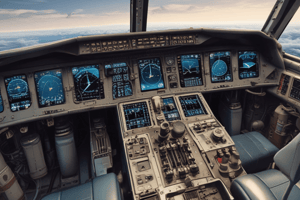Podcast
Questions and Answers
What is the primary function of trim systems in aircraft?
What is the primary function of trim systems in aircraft?
- To calculate load factors during maneuvers
- To automate fine adjustments to maintain a stable flight attitude (correct)
- To maintain level flight during autopilot mode
- To generate lift by changing the angle of attack
What is the primary force that enables flight?
What is the primary force that enables flight?
- Drag
- Lift (correct)
- Weight
- Thrust
What is the purpose of load factors in aircraft operations?
What is the purpose of load factors in aircraft operations?
- To automate flight control systems
- To calculate the aircraft's fuel consumption
- To determine the aircraft's maximum speed
- To ensure the structural integrity and safety of the aircraft (correct)
What is the role of the airfoil shape in generating lift?
What is the role of the airfoil shape in generating lift?
What is the primary benefit of autopilot systems in aircraft?
What is the primary benefit of autopilot systems in aircraft?
What is the delicate balance between lift and weight critical for?
What is the delicate balance between lift and weight critical for?
What is the purpose of the Aircraft Flight Manual/Pilot's Operating Handbook (AFM/POH)?
What is the purpose of the Aircraft Flight Manual/Pilot's Operating Handbook (AFM/POH)?
What is the result of a well-balanced interplay between lift and weight?
What is the result of a well-balanced interplay between lift and weight?
What is the role of flight simulators in pilot training?
What is the role of flight simulators in pilot training?
What is the ultimate goal of mastering flight control systems?
What is the ultimate goal of mastering flight control systems?
Fly-by-wire systems provide tactile feedback and direct control.
Fly-by-wire systems provide tactile feedback and direct control.
The rudder's role in managing an aircraft's yaw is optional during adverse conditions.
The rudder's role in managing an aircraft's yaw is optional during adverse conditions.
T-tail aircraft designs are more common due to their aerodynamic advantages.
T-tail aircraft designs are more common due to their aerodynamic advantages.
Leading edge devices, such as slats and Krueger flaps, are used to increase drag.
Leading edge devices, such as slats and Krueger flaps, are used to increase drag.
Spoilers are used to increase lift during takeoff.
Spoilers are used to increase lift during takeoff.
Autopilot systems can only follow predetermined flight paths.
Autopilot systems can only follow predetermined flight paths.
Mechanical systems are more complex than fly-by-wire systems.
Mechanical systems are more complex than fly-by-wire systems.
Rudder control is only necessary during crosswinds.
Rudder control is only necessary during crosswinds.
T-tail aircraft designs are more prone to stall due to their unique aerodynamic challenges.
T-tail aircraft designs are more prone to stall due to their unique aerodynamic challenges.
Spoilers are only used during landing.
Spoilers are only used during landing.
What is the primary advantage of fly-by-wire systems over mechanical systems?
What is the primary advantage of fly-by-wire systems over mechanical systems?
During what conditions is the rudder's role in managing an aircraft's yaw particularly crucial?
During what conditions is the rudder's role in managing an aircraft's yaw particularly crucial?
What is the unique challenge faced by T-tail aircraft designs during stall recovery?
What is the unique challenge faced by T-tail aircraft designs during stall recovery?
What is the primary function of leading edge devices, such as slats and Krueger flaps?
What is the primary function of leading edge devices, such as slats and Krueger flaps?
What is the dual purpose of spoilers in aircraft systems?
What is the dual purpose of spoilers in aircraft systems?
What is the primary benefit of autopilot systems in reducing pilot workload?
What is the primary benefit of autopilot systems in reducing pilot workload?
What is the primary difference between mechanical and fly-by-wire systems in terms of complexity?
What is the primary difference between mechanical and fly-by-wire systems in terms of complexity?
What is the critical role of the rudder in maintaining directional control?
What is the critical role of the rudder in maintaining directional control?
What is the primary advantage of T-tail aircraft designs despite their unique aerodynamic challenges?
What is the primary advantage of T-tail aircraft designs despite their unique aerodynamic challenges?
What is the primary purpose of deploying spoilers on the ground?
What is the primary purpose of deploying spoilers on the ground?
Flashcards are hidden until you start studying
Study Notes
Fundamentals of Flight: Mastering Aircraft Control Systems
- The four fundamental aerodynamic forces are: thrust, drag, lift, and weight.
- Understanding these forces is crucial for pilots as they dictate the aircraft's response to their commands.
Aircraft Performance Metrics
- Key parameters are outlined in the Aircraft Flight Manual or Pilot's Operating Handbook.
- Knowing the limits and capabilities of the aircraft is essential, like knowing the heart rate of a thoroughbred mid-gallop.
Aircraft Control Systems
- Mechanical linkages, rods, pulleys, and cables act as an extension of a pilot's will, translating intention into aerial ballet with precision and grace.
- Mastering these components is critical for pilots to breathe life into the aircraft's ailerons, influencing roll and responsible flight.
Aircraft Roll Control
- Ailerons are responsible for roll control, and slight inputs can pivot an aircraft on its longitudinal axis.
- Proper coordination of ailerons and rudder is essential to perform harmonious turns, minimizing the potential for adverse yaw.
T-Tail Aircraft Design
- The T-tail design features a vertical stabilizer, significantly impacting stall recovery and control effectiveness.
- The T-tail's distinct silhouette speaks to its aerodynamic advantages and challenges.
Secondary Control Surfaces
- Flaps and leading edge devices fine-tune the aircraft's performance, adjusting lift and drag for the perfect pitch during crucial phases like takeoff and landing.
- Spoilers play a dual role in manipulating lift and drag, adding another layer to the control repertoire.
Trim Systems
- Trim systems bestow upon the aircraft the gift of stable flight, easing the pilot's workload and allowing focus on navigation and strategy.
- Introducing harmony into the cockpit, trim systems ensure stable flight and optimal performance.
Autopilot Systems
- Autopilot systems maintain level flight and adhere to programmed flight paths, lending pilots a digital copilot to shoulder the journey's demands.
- These systems are essential for modern flight, offering pilots a reliable and efficient way to manage the aircraft's behavior.
Consolidated Landscape of Flight Control Systems
- The mastery of flight control systems is a lifelong voyage, shaped by knowledge, refined by experience, and inspired by the limitless sky.
- Each component functions harmoniously to govern the majestic dance of aircraft through the clouds.
Essential Concepts
- Thrust propels the aircraft forward, overcoming the retarding force of drag.
- Stall speeds are crucial for aviators to gauge, as they dictate the speed limit of the skies.
- Fly-by-wire control systems offer precision and reliability, translating pilot inputs into electronic signals.
- Elevators are used to adjust an aircraft's pitch, essential for climbing or descending within the atmospheric theatre.
- Adverse yaw is minimized through techniques that ensure smooth, coordinated turns.
- The T-tail design prevents flutter and improves control at higher speeds.
- Flaps enhance lift during takeoff and landing, while spoilers contribute to roll control.
- Trim systems reduce pilot workload, automating fine adjustments to maintain a stable flight attitude.
- Autopilot systems maintain level flight, relying on sophisticated algorithms to offer the pilot restful moments amidst the demanding environment of the cockpit.
Fundamentals of Flight: Mastering Aircraft Control Systems
- The four fundamental aerodynamic forces are thrust, drag, lift, and weight.
- Understanding these forces is crucial for pilots as they dictate the aircraft's response to their commands.
Aircraft Performance Metrics
- Key parameters are outlined in the Aircraft Flight Manual or Pilot's Operating Handbook.
- Knowing the limits and capabilities of the aircraft is essential for pilots.
Control Systems
- Mechanical linkages, rods, pulleys, and cables translate pilot inputs into aerial movements.
- Mastering control systems is critical for pilots to breathe life into the aircraft's ailerons.
Roll Control
- Ailerons are responsible for roll control.
- Understanding roll control is essential for smooth and coordinated turns.
Aircraft Stability and Control
- Trim systems automate fine adjustments to maintain a stable flight attitude.
- Autopilot systems tirelessly maintain level flight, relying on sophisticated algorithms.
Thrust and Drag
- Thrust propels the aircraft forward, overcoming drag.
- Pilots must skillfully manage thrust to ensure efficiency and safety throughout every phase of flight.
Stall Speeds
- Stall speeds are found through meticulous calculations outlined in the Aircraft Flight Manual or Pilot's Operating Handbook.
- Knowing stall speeds is crucial for pilots to avoid losing control.
Fly-by-Wire Control Systems
- Fly-by-wire systems translate pilot inputs into electronic signals, creating a whole new level of precision and reliability.
- These systems enhance precision, reduce weight, and allow for advanced automation.
Elevator and Pitch
- The elevator is the primary tool for adjusting an aircraft's pitch.
- Pilots can angle the nose of the craft upward or downward using the elevator.
Adverse Yaw
- Adverse yaw occurs when an aircraft's nose tends to skew from the intended path during turns.
- Techniques to minimize adverse yaw include coordinated turns and rudder input.
T-Tail and Flutter Prevention
- The T-tail design reduces the risk of aerodynamic instability, allowing for improved control at higher speeds.
- The elevated position of the T-tail prevents flutter and enhances stability.
Flaps and Lift
- Flaps enhance lift during takeoff and landing by increasing the wing's surface area.
- Flaps are crucial for reducing stall speeds and increasing safety during critical phases of flight.
Spoilers and Roll Control
- Spoilers contribute to roll control by deploying on one wing and bringing it downward while the other rises.
- Spoilers also increase drag and reduce lift during landing.
Autopilot Systems
- Autopilot systems maintain level flight, relying on sophisticated algorithms to offer the pilot restful moments.
- These systems are engineered to follow predetermined flight paths and reduce pilot workload.
Load Factors and Performance Metrics
- Load factors quantify the stress exerted on an aircraft structure during maneuvers.
- Load factors are calculated using information from the Aircraft Flight Manual/Pilot's Operating Handbook.
Rudder and Yaw
- The rudder's role in managing an aircraft's yaw is indispensable, particularly during adverse conditions.
- By manipulating the rudder, pilots can maintain directional control and compensate for forces that may otherwise cause the aircraft to deviate from its intended flight path.
Fundamentals of Flight: Mastering Aircraft Control Systems
- The four fundamental aerodynamic forces are thrust, drag, lift, and weight.
- Understanding these forces is crucial for pilots as they dictate the aircraft's response to their commands.
Aircraft Performance Metrics
- Key parameters are outlined in the Aircraft Flight Manual or Pilot's Operating Handbook.
- Knowing the limits and capabilities of the aircraft is essential for pilots.
Control Systems
- Mechanical linkages, rods, pulleys, and cables translate pilot inputs into aerial movements.
- Mastering control systems is critical for pilots to breathe life into the aircraft's ailerons.
Roll Control
- Ailerons are responsible for roll control.
- Understanding roll control is essential for smooth and coordinated turns.
Aircraft Stability and Control
- Trim systems automate fine adjustments to maintain a stable flight attitude.
- Autopilot systems tirelessly maintain level flight, relying on sophisticated algorithms.
Thrust and Drag
- Thrust propels the aircraft forward, overcoming drag.
- Pilots must skillfully manage thrust to ensure efficiency and safety throughout every phase of flight.
Stall Speeds
- Stall speeds are found through meticulous calculations outlined in the Aircraft Flight Manual or Pilot's Operating Handbook.
- Knowing stall speeds is crucial for pilots to avoid losing control.
Fly-by-Wire Control Systems
- Fly-by-wire systems translate pilot inputs into electronic signals, creating a whole new level of precision and reliability.
- These systems enhance precision, reduce weight, and allow for advanced automation.
Elevator and Pitch
- The elevator is the primary tool for adjusting an aircraft's pitch.
- Pilots can angle the nose of the craft upward or downward using the elevator.
Adverse Yaw
- Adverse yaw occurs when an aircraft's nose tends to skew from the intended path during turns.
- Techniques to minimize adverse yaw include coordinated turns and rudder input.
T-Tail and Flutter Prevention
- The T-tail design reduces the risk of aerodynamic instability, allowing for improved control at higher speeds.
- The elevated position of the T-tail prevents flutter and enhances stability.
Flaps and Lift
- Flaps enhance lift during takeoff and landing by increasing the wing's surface area.
- Flaps are crucial for reducing stall speeds and increasing safety during critical phases of flight.
Spoilers and Roll Control
- Spoilers contribute to roll control by deploying on one wing and bringing it downward while the other rises.
- Spoilers also increase drag and reduce lift during landing.
Autopilot Systems
- Autopilot systems maintain level flight, relying on sophisticated algorithms to offer the pilot restful moments.
- These systems are engineered to follow predetermined flight paths and reduce pilot workload.
Load Factors and Performance Metrics
- Load factors quantify the stress exerted on an aircraft structure during maneuvers.
- Load factors are calculated using information from the Aircraft Flight Manual/Pilot's Operating Handbook.
Rudder and Yaw
- The rudder's role in managing an aircraft's yaw is indispensable, particularly during adverse conditions.
- By manipulating the rudder, pilots can maintain directional control and compensate for forces that may otherwise cause the aircraft to deviate from its intended flight path.
Studying That Suits You
Use AI to generate personalized quizzes and flashcards to suit your learning preferences.




